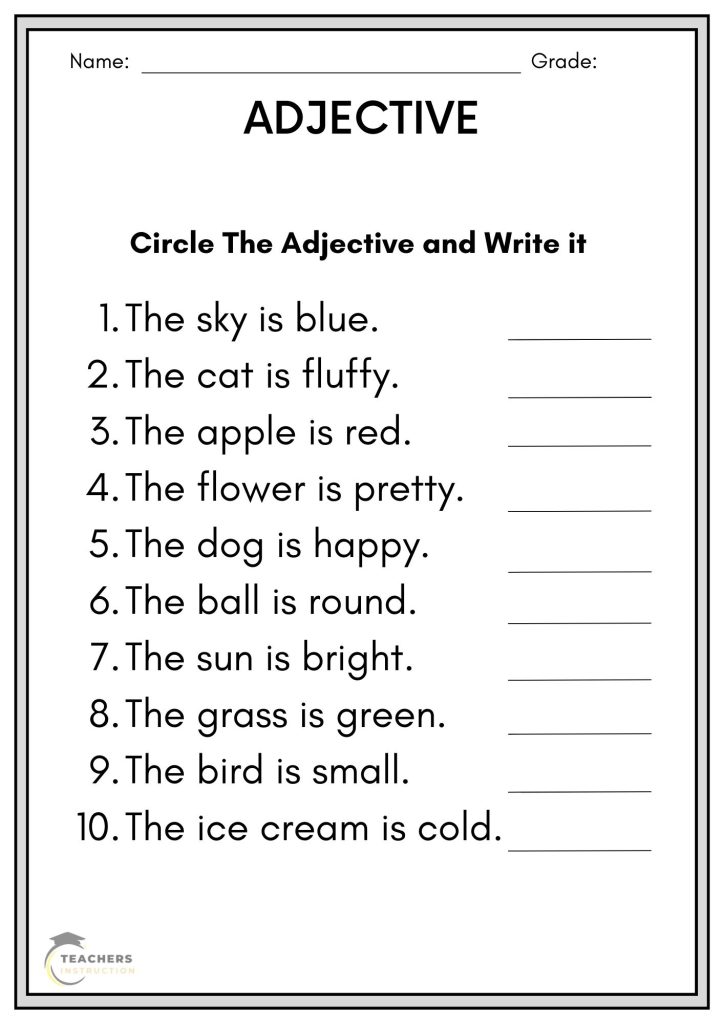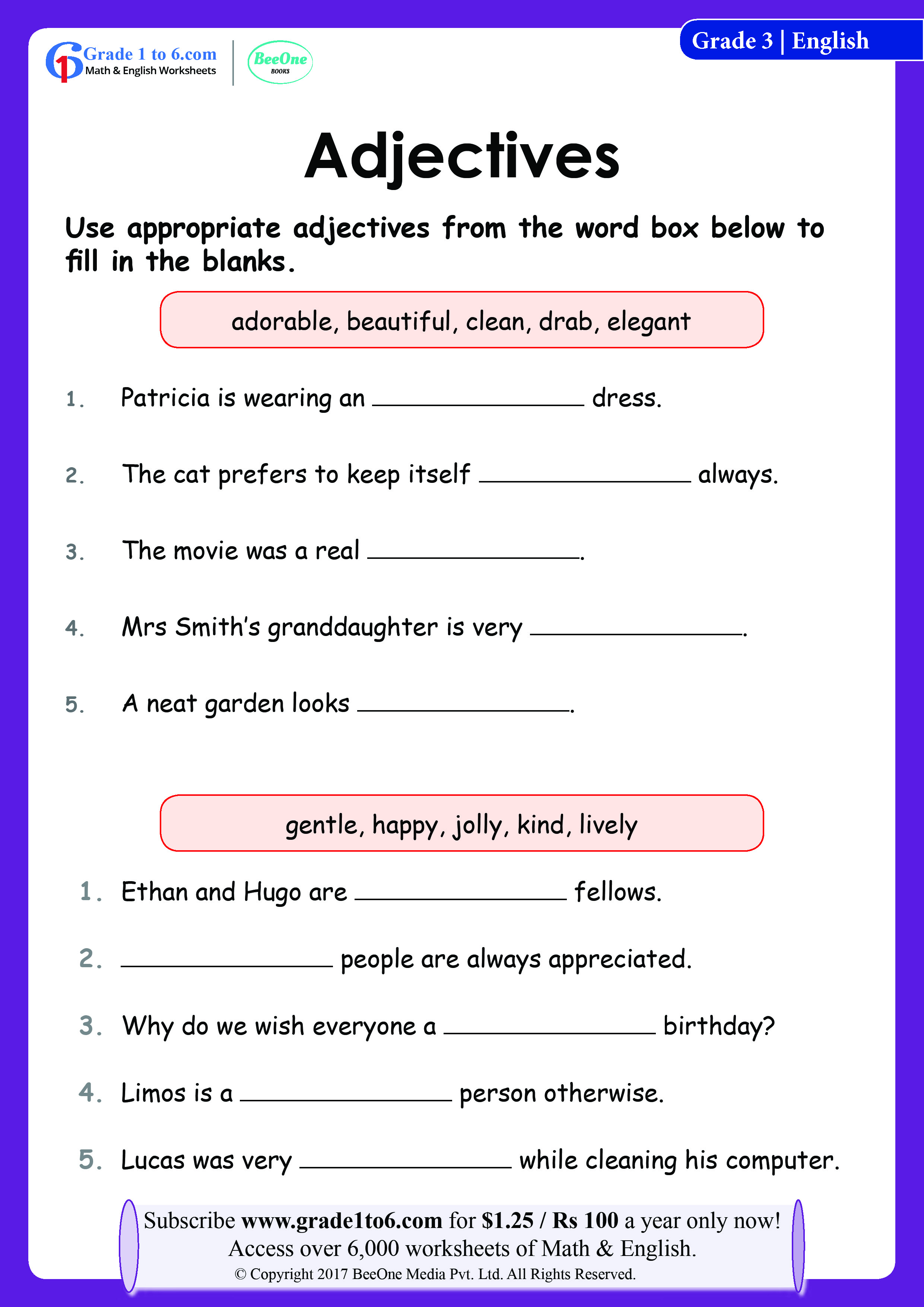
Mastering Description: The Power of Adjective Classroom Activity Worksheets
Language is a vast and intricate tapestry, and within its threads, adjectives serve as the vibrant dyes that bring words to life. They allow us to paint vivid pictures, convey precise emotions, and differentiate between countless nuances. For students, understanding and effectively using adjectives is not merely a grammatical exercise; it’s a foundational skill that unlocks more expressive writing, clearer communication, and sharper critical thinking. In this quest to cultivate descriptive mastery, adjective classroom activity worksheets emerge as an indispensable tool, offering structured practice, engaging challenges, and measurable progress.
This comprehensive article will delve into the profound importance of adjectives, explore the myriad benefits and types of well-crafted adjective classroom activity worksheets, and provide practical guidance on designing and implementing them to foster a deeper understanding and appreciation for the power of descriptive language in students of all ages.
The Indispensable Role of Adjectives in Language

Before diving into the mechanics of worksheets, it’s crucial to appreciate why adjectives matter so much. Adjectives are words that describe or modify nouns and pronouns, providing additional information about their qualities, quantities, or characteristics. Without them, our language would be flat, generic, and uninspiring.

Consider the difference between "a house" and "a dilapidated, haunted, Victorian house." The adjectives transform a simple noun into a detailed image, evoking a specific atmosphere and inviting further inquiry. They are the backbone of descriptive writing, allowing authors to transport readers into their imagined worlds. In speaking, they enable us to articulate our observations with precision, whether we’re describing a "delicious meal," a "challenging problem," or a "beautiful sunset."

For students, a strong grasp of adjectives translates directly into:

- Enhanced Writing: Their narratives become richer, their arguments more persuasive, and their reports more informative. They learn to "show, don’t tell."
- Improved Reading Comprehension: They can better visualize scenes, understand character traits, and grasp the nuances of an author’s tone.
- Sharpened Critical Thinking: Identifying and analyzing adjectives encourages students to observe details, make distinctions, and articulate their perceptions more accurately.
- Richer Vocabulary: Learning new adjectives expands their linguistic toolkit, empowering them to express themselves with greater variety and sophistication.


Given this profound impact, educators are constantly seeking effective methods to teach adjectives. This is where adjective classroom activity worksheets prove their immense value.
The Unquestionable Benefits of Adjective Classroom Activity Worksheets

The utility of well-designed adjective classroom activity worksheets cannot be overstated. They offer a structured, tangible, and often engaging way for students to practice, reinforce, and consolidate their understanding of adjectives.
- Structured Practice: Worksheets provide a systematic approach to learning. They can guide students through different stages of understanding, from simple identification to complex application. This structured environment helps reduce cognitive load and allows students to focus on one skill at a time.
- Reinforcement and Repetition: Like any skill, mastery of adjectives requires practice. Worksheets offer opportunities for repeated exposure to concepts, helping to solidify understanding and move knowledge from short-term to long-term memory.
- Differentiation: A well-designed set of worksheets can easily be adapted to meet the diverse needs of learners. Simpler worksheets can support struggling students, while more complex or creative tasks can challenge advanced learners.
- Assessment Tool: Worksheets provide a quick and easy way for teachers to gauge student comprehension. They offer clear evidence of what students know and where they might be struggling, informing future instruction.
- Independent Learning: Many worksheets can be completed independently, fostering self-reliance and allowing students to work at their own pace. This frees up the teacher to provide individualized support where needed.
- Prepares for Complex Tasks: By mastering the foundational skills through worksheets, students are better equipped to tackle more complex writing assignments, oral presentations, and analytical tasks that require a nuanced understanding of descriptive language.
- Engagement (When Done Right): While often seen as traditional, modern worksheets can incorporate games, puzzles, creative prompts, and real-world scenarios, making the learning process genuinely enjoyable.


A Panorama of Adjective Classroom Activity Worksheet Types
The versatility of adjective classroom activity worksheets lies in the wide array of formats and activities they can encompass. Here’s a look at some popular and effective types:
-
Identification Worksheets:
- Underline/Circle the Adjectives: Students are given sentences or paragraphs and asked to identify all the adjectives. This is often the first step in teaching adjectives.
- Adjective Hunt: Students read a short story or article and list all the adjectives they find.
-
Matching Worksheets:
- Adjective to Noun Matching: Students match a list of adjectives to a list of appropriate nouns (e.g., "sparkling" to "diamond," "brave" to "knight").
- Antonym/Synonym Matching: Students match adjectives with their opposites or words with similar meanings, expanding vocabulary.
-
Completion and Fill-in-the-Blanks:
- Sentence Completion: Students fill in blanks with appropriate adjectives from a word bank or their own ideas (e.g., "The __ cat purred.").
- Sentence Expansion: Students are given simple sentences and asked to add 2-3 adjectives to make them more descriptive (e.g., "The tree stood." becomes "The tall, ancient, gnarled tree stood.").
-
Creative and Application Worksheets:
- Picture Description: Students are shown a picture (of a person, animal, scene, or object) and asked to list as many adjectives as they can to describe it. This can lead to writing descriptive paragraphs.
- Character/Object Profile: Students create a profile of a fictional character or object, using a specific number of adjectives to describe their appearance, personality, or features.
- Sensory Adjectives: Worksheets focusing on adjectives related to the five senses (e.g., "How does a lemon taste? (sour, tangy)").
- Describing Emotions: Students use adjectives to describe various feelings and emotions (e.g., "How do you feel when you win? (ecstatic, joyful)").
-
Comparative and Superlative Adjectives:
- Forming Degrees: Worksheets where students practice forming the comparative and superlative forms of given adjectives (e.g., "big, bigger, biggest").
- Sentence Application: Students use comparative and superlative adjectives in sentences to compare two or more things.
-
Order of Adjectives:
- Ordering Exercises: Students rearrange a list of adjectives to follow the conventional order (opinion, size, age, shape, color, origin, material, purpose).
- Sentence Construction: Students build sentences using multiple adjectives in the correct order.
-
Error Correction/Editing:
- Identify and Correct: Students find and correct misused or redundant adjectives in sentences or short passages.
-
Game-Based Worksheets:
- Adjective Word Search/Crossword: Fun ways to reinforce adjective vocabulary.
- Adjective Bingo: Students cross off adjectives as the teacher calls them out, or as they find them in a text.
Designing Effective Adjective Classroom Activity Worksheets
The effectiveness of any worksheet hinges on its design. Here are key principles for creating impactful adjective classroom activity worksheets:
- Clear and Concise Instructions: Students should know exactly what they need to do without ambiguity. Use simple language and provide an example if necessary.
- Age and Skill Appropriateness: The complexity of vocabulary, sentence structure, and tasks should match the developmental stage of the students.
- Varied Activities: Don’t stick to just one type of exercise. Mix identification with application, matching with creative writing, to keep students engaged and address different learning styles.
- Visual Appeal: Use clear fonts, appropriate spacing, and relevant images or graphics to make the worksheet inviting and easy to read. Avoid clutter.
- Relevance and Context: Connect the adjectives to topics that are interesting or familiar to students (e.g., describing their favorite animals, foods, or sports heroes).
- Scaffolding: Gradually increase the difficulty. Start with simpler tasks and move to more complex ones within the same worksheet or across a series of worksheets.
- Opportunities for Creativity: Encourage students to use their own ideas and imaginations, especially in application-based tasks.
- Self-Correction/Answer Keys (Optional): For independent practice, providing an answer key (perhaps on a separate sheet) can allow students to check their work and learn from their mistakes immediately.
Implementing Adjective Classroom Activity Worksheets in the Classroom
Designing great worksheets is only half the battle; effective implementation is crucial for maximizing their impact.
- Pre-Teaching and Introduction: Before handing out the worksheet, ensure students understand the concept of adjectives. Use examples, anchor charts, and interactive discussions. The worksheet should reinforce, not introduce, the core concept.
- Model and Demonstrate: Go through the first one or two questions together as a class. Model how to approach the task and articulate your thought process.
- Individual, Pair, or Group Work: Decide whether the worksheet is best completed individually (for assessment or focused practice), in pairs (for peer discussion and support), or in small groups (for collaborative learning and problem-solving).
- Teacher as Facilitator: Circulate around the room, providing support, answering questions, and offering gentle prompts. Avoid giving direct answers; instead, guide students to discover the answers themselves.
- Post-Activity Discussion and Review: Once completed, review the answers as a class. This is a critical step for clarifying misconceptions, reinforcing correct usage, and allowing students to learn from each other. Discuss why certain adjectives are effective and others are not.
- Differentiation Strategies:
- Support: Provide word banks, sentence starters, or reduce the number of questions for struggling learners. Offer one-on-one assistance.
- Challenge: Encourage advanced learners to write additional sentences, use more sophisticated adjectives, or apply the concept to a mini-writing project.
- Integration with Other Subjects: Encourage students to identify and use adjectives in science descriptions, history narratives, or art critiques. This cross-curricular application reinforces the importance of descriptive language.
- Feedback and Assessment: Provide constructive feedback on completed worksheets. Use them to identify common errors and plan future lessons.
Beyond the Worksheet: Extending Adjective Learning
While adjective classroom activity worksheets are powerful, they are just one component of a holistic approach to teaching adjectives. To truly embed the skill, extend learning beyond the paper:
- Oral Description Games: Play "I Spy" using adjectives, or describe a secret object using only adjectives until others guess it.
- "Adjective of the Day/Week": Introduce a new adjective daily or weekly, discuss its meaning, and challenge students to use it in conversation or writing.
- Creative Writing Projects: Assign short stories, poems, or descriptive essays where the effective use of adjectives is a key assessment criterion.
- Real-World Observation: Take students on "adjective walks" where they observe their surroundings and list adjectives to describe what they see, hear, smell, and feel.
- Technology Integration: Use interactive online games, digital storytelling tools, or presentation software to create multimedia projects rich in descriptive language.
- Peer Editing: Train students to identify and suggest improvements for adjective usage in their classmates’ writing.
Conclusion
Adjectives are the color palette of language, transforming ordinary sentences into vibrant expressions. The journey to mastering them is an ongoing process that benefits immensely from structured practice. Adjective classroom activity worksheets, when thoughtfully designed and effectively implemented, serve as an invaluable resource in this journey. They provide the necessary framework for identification, understanding, and application, empowering students to wield descriptive language with confidence and creativity. By embracing these versatile tools, educators can unlock their students’ potential to become not just proficient writers and speakers, but also keen observers of the world around them, capable of articulating its richness and complexity with precision and flair.
